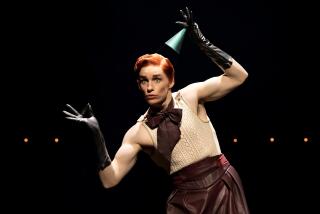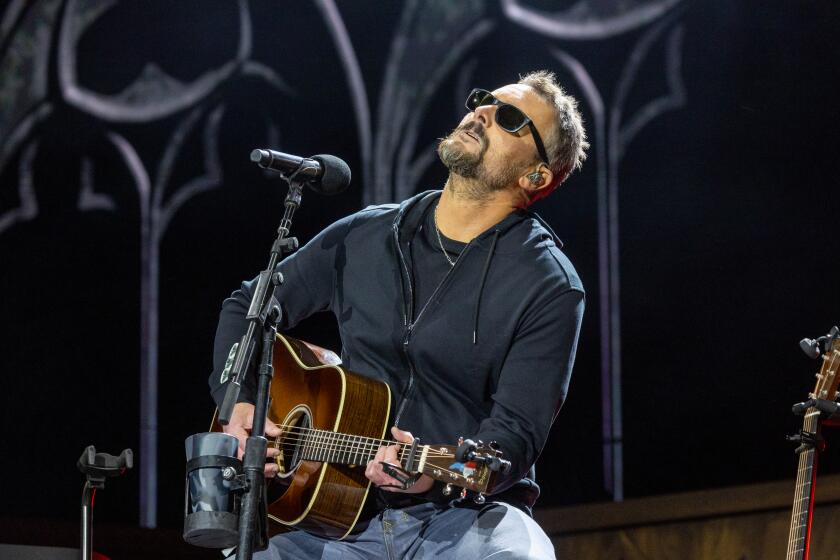Depictions of violence in theater: Revelation, not nihilism
In one of the most infamous scenes in modern drama, a group of young men in a London park stone a baby to death in its carriage. What begins as roughhousing escalates to all-out sadism until a rock is thrown at point blank range, ending the child’s pitiful cries for good.
Edward Bond’s “Saved” provoked outrage when it was produced in 1965 by the Royal Court Theatre as a private club offering, a designation used to slip past the Lord Chamberlain’s Office. Although “Saved” isn’t revived often, it’s considered a modern classic, and not just because it was instrumental in overturning Britain’s strict theater censorship laws.
The play had a formative influence on playwrights Mark Ravenhill and Sarah Kane, and it’s hard to imagine the flamboyant thuggery of Tracy Letts and Martin McDonagh, two of contemporary theater’s sharpest stylists, without Bond’s path-clearing example.
THE CULTURE OF VIOLENCE: Art | Film | Television | Hollywood
Even by today’s standards, “Saved” is shocking. Bond, who once acknowledged that he writes “about violence as naturally as Jane Austen wrote about manners,” captures the murder in all its bleak sociological detail. Against a seedy urban background of utter futility, the young mother’s temporary abandonment of her baby is made chillingly plausible, as is the pack-like behavior of the men who torture the baby for perverse distraction from their aimless lives.
While seeing the play off-Broadway in a production directed by Robert Woodruff in 2001, I wasn’t sure if I’d be able to withstand the spectacle of a baby being smeared with its own excrement and nakedly throttled. I had barely survived an earlier scene in which the child’s intensifying cries went unanswered in a London household too bogged down in its own misery to respond.
The real world being sufficiently generous when it comes to doling out violence, I don’t intentionally seek it out in drama. Additionally, I have found it harder in my middle years to detach blows from the physical and mental suffering they entail. (Sadly, the unreality of youth doesn’t last forever.) Yet I would have been in solidarity with those who stood up for “Saved” against those who were loudly condemning the work as obscene when it was first done.
What is the line between acceptable and unacceptable violence in art? If gruesomeness is the criterion, much of Jacobean drama would have to be banned, including Shakespeare’s “King Lear,” with its graphic scene of Gloucester’s eyes being mercilessly plucked out. Some may believe they can identify pornography at a glance, but violence places keener demands on our sensibilities. Its artistic validity isn’t a function of how many liters of blood are spilled or how many limbs are dismembered. The question is one of gratuitousness. Or to put it another way: How does the brutality fit into a work’s larger vision?
The task is uniquely challenged. Make-believe violence is a tool that all too easily becomes an indiscriminate weapon. It is a form of knowledge — of the body’s vulnerability, of the aggression that lurks in the hearts of men — but it can also be a pernicious seduction, luring artists and audiences toward a nihilistic celebration of the destruction of meaning itself.
THE CULTURE OF VIOLENCE: Video Games | World Cinema
The British psychoanalyst Adam Phillips has spoken of the “inured, detached horror” that comes as a result of being glutted with images of human suffering. “The sadomasochistic solution to this is to find it all incredibly exciting and gripping and to want more and more of it,” he explained in Bomb Magazine. “That is a catastrophe created by a culture that makes suffering and exploitation bearable by making or cultivating a sadomasochistic pleasure.”
In the “Poetics,” Aristotle takes up the question of why human beings delight in contemplating objects that in reality bring them pain. His answer is that man is essentially an imitative animal who learns by copying the world around him. Yet Aristotle doesn’t claim that this instinct alone justifies the portrayal of any kind of atrocity. The crux of his argument is that the dramatization of certain types of calamity can have a positive moral effect. In fact, rather than feeding the unruly passions (one of Plato’s big beefs with poetry), these depictions have the power to calm the emotional waters by stirring them up.
Like Freud, Aristotle thought that repression carries more dangers than representation. Yet his theory of catharsis — for him, the raison d’être of tragedy — isn’t unlimited. There are experiences better left undramatized. The test of an action’s moral suitability, however, lies in its artistic ends, not in its inherent balefulness.
Yes, even the stoning of a baby can be dramatically justified. Bond, a key figure in Britain’s impressive band of postwar political playwrights, wrote “Saved” as a cautionary tale about the dehumanizing effects of inequitable social conditions. The wanton killing in “Saved” may seem shamelessly sensationalistic, but it is embedded in a work that closely examines the corrosiveness of economic injustice on human dignity.
Revenge has historically been the motive behind a good deal of violence in the theater. Where there’s a cold corpse onstage, there’s usually a claim for self-imposed law and order. Indeed blood and gore have been bound up with the question of justice since Clytemnestra hacked her husband to death in his bath in Aeschylus’ “Oresteia.”
THE CULTURE OF VIOLENCE: On-screen history | Theater | Research
Contemporary playwrights, influenced more by Hollywood than by Shakespeare and the Greeks, have become increasingly comfortable in detaching violence from the conflict that is at the complicated heart of justice, the arbitration of unequal loss. Guns, knives and other weaponry are in danger of becoming attention-grabbing accessories in the homicidal diversions that our popular culture can never get enough of and that are perhaps the purest manifestation of a society that would rather sacrifice schoolchildren than amend firearm laws.
The bone-crunching, hand-burning comedies of McDonagh are undeniably hilarious, but they are part of a disturbing trend that celebrates work more for its style than for its mind, more for its artistry than for its artistic vision. The scene in Letts’ “Killer Joe” in which the title character sexually assaults a double-dealing woman with a drumstick is one that might have impressed the playwright’s 17th century English forebears, but the theater is on a slippery slope when it tries to compete with the lurid tactics of moviemaking. (No surprise that William Friedkin exploited the moment in his film version for all its animal ferocity.)
Theater is fundamentally a metaphorical space, one inviting critical inquiry. Words have an equal footing with images, unlike in film, and the very limitations of the stage open up intellectual advantages.
Harold Pinter’s comedies of menace, which lay bare the territorial nature of human beings in language that is as sharp as a switchblade, have a revelatory quality that engages me on a deeper level than McDonagh’s bruising farces, which strike me as more indebted to the films of Quentin Tarantino, whose desire to entertain outstrips his ability to think. (The hyperventilating praise for “Django Unchained” was for me one of the more depressing end-of-the-year occurrences, particularly in the righteous justification of a work that undermined the credibility of its historical depiction of the barbarity of slavery by treating violent death as a tediously repetitive pop-cultural joke.)
This might sound prudish, but I had no trouble appreciating Sarah Kane’s “Blasted,” in which, perhaps in an attempt to outdo both “Lear” and “Saved,” a pair of eyes and a baby are eaten in an apocalyptic drama that brings war into an intimate hotel room setting. But then I think it’s important to note the vantage point of an artist who makes violence her subject. Kane, who took her own life at age 28, filled the stage with unbearable torment. But the nightmare images of her plays are deeply inhabited by the author, who never failed to register the emotional cost of horror.
THE CULTURE OF VIOLENCE: Art | Film | Television | Hollywood
The same can be said for Belarus Free Theatre, the courageous troupe that made a devastating and all-too-brief recent appearance at the Segerstrom Center with “Minsk, 2011: A Reply to Kathy Acker.” This company creates harrowing imagistic productions with an urgency that is in direct proportion to the oppressive situation its members find themselves in back home. In a series of vicious theatrical snapshots, “Minsk” conjured a cityscape that draws analogies between political torture and sexual commerce, between totalitarian domination and self-abasement. My response was twofold — stunned amazement at the performers’ liberated craft and a wish that the real-world hell stoking their collective brilliance would end immediately.
In considering the question of who is bearing witness, it can be useful to note whether the repair work is included along with the destruction. Those who have felt a boot against their throat are unlikely to leave out some intimation of what it’s like to overcome this suffering. The plays of Adrienne Kennedy (“Funnyhouse of a Negro,” “The Ohio State Murders”) and Maria Irene Fornes (“Mud,” “The Conduct of Life,” “Fefu and Her Friends”) are among the most eloquent ever written on the shattering effects of violence. These dramatists go beyond the recording of trauma — they articulate the numbed, fractured space left in its wake.
“Nature’s above art,” Shakespeare asserts in “Lear,” in producing “side-piercing sights.” But then he proceeds to unfurl one of the most heart-rending scenes in literature, the meeting between the old king, whose mind has cracked from furious sorrow, and the blinded Gloucester. Victims both, they are neither innocent nor commensurately punished, but together they grope toward a theatrical poetry worthy of their wounds.
More to Read
The biggest entertainment stories
Get our big stories about Hollywood, film, television, music, arts, culture and more right in your inbox as soon as they publish.
You may occasionally receive promotional content from the Los Angeles Times.








